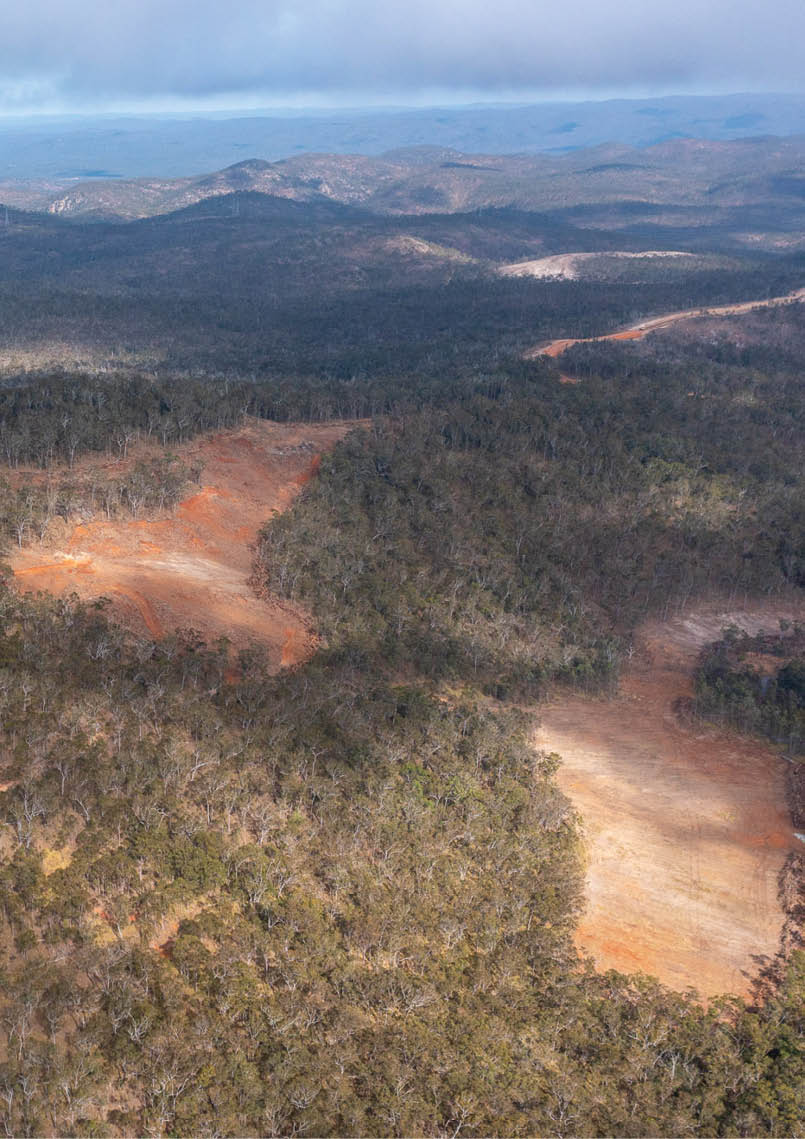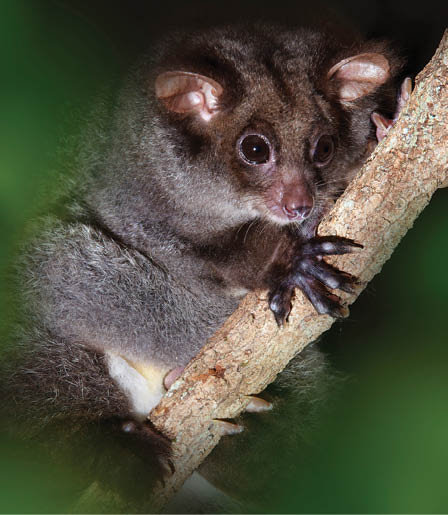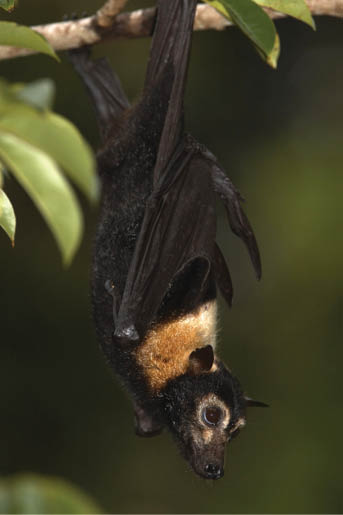


Land clearing for Kaban wind development, taken in September 2021
In Far North Queensland (FNQ) in landscapes with high biodiverse values, numerous large-scale industrial renewable energy projects are proposed. These locations are inappropriate.

Queensland Windfarms and Habitat Loss
Carolyn EmmsPresident, Rainforest Reserves Australia

52 | BWA February 2022

Rainforest Reserves Australia (RRA) are a small group of hands-on regenerative conservationists who operate the Tablelands Cassowary Facility in partnership with the Queensland Department of Environment and Science. RRA have a particularly high stake in the conservation of the landscapes of FNQ. We care for sick, injured and orphaned Cassowaries and release them to the wild once they’re ready. The Atherton Tablelands is now home to some of our released Cassowaries and these big birds claim large territories of land and often roam far and wide, impervious to cars, roads, signs, fencing and any other human intervention.
Cassowaries and other iconic wildlife of FNQ are now facing two main existential threats: habitat loss and climate warming. Habitat loss accounts for the majority of species extinction in Queensland. While climate change requires a prompt move away from fossil fuels into renewable energy sources, the construction of industrial-scale renewable energy developments – or any developments for that matter - on the high-biodiversity landscapes of our region is ill-considered. Losing our forests and grasslands will negatively impact the water cycle, contribute
to species loss, contribute to habitat loss, increase degradation, and fragment habitat. These will assuredly impact the capacity of our highly vegetated region to absorb carbon.
Wilderness and wildlife collateral damageThere are at least 17 large-scale renewable energy developments planned for FNQ and there may be more in the wings. The majority of these proposals impact the habitat of EPBC Listed Endangered or Vulnerable wildlife yet the requisite land-clearing will result in thousands of acres of vital habitat lost. According to recent estimates by ABC journalist Mayeta Clark, should all renewable energy proposals go ahead in Queensland, an estimated 13,332 hectares of remnant vegetation will be cleared statewide and 90 per cent of the land clearing will take place in North Queensland.
The scale of impending habitat clearance required for so many proposed renewable energy developments in FNQ is catastrophic. Clearing that amount of landscape for “green energy” runs counter to any good sense, which suggests we conserve our wild places and high biodiversity habitat for future generations to enjoy.
Greater glider, endangered in Queensland and vulnerable nationally

Spectacled flying-foxes are endangered and live on the Tablelands region
BWA February 2022 | 53
.jpg)

Ring of Steel Atherton TablelandsWe’re confronted with a looming ecological disaster when we consider that, if approved, five industrial-scale wind developments are to be crowded into a small highly biodiverse pocket of the Ravenshoe region at the southern end of the Atherton Tablelands.
There are wind farms proposed for Chalumbin, Windy Hill, High Road and Mount Emerald. If all projects are approved, this is a minimum of 213 wind turbines within a short distance of each other on the Southern end of the Atherton Tablelands.
In painting this picture I hope that you can envisage the “ring of steel” that the wind developments will create, impacting rare and endangered migratory birds, raptors and bats in ways that have not been anticipated in any legislation.
See the videos on land clearing in the Chalumbin and Kaban areas near Ravenshoe.
The fading call of the Sarus CraneThe small populations of Brolgas and Sarus Cranes are beloved to the people of the Atherton Tablelands. A world-renowned specialist on these birds Dr Tim Nevard,
who lives in Ravenshoe, recently presented research on the impact this wind turbine “ring of steel” will have on nearby roosting Brolgas and Sarus Cranes. He reveals the five-kilometre buffer zones around Kaban and Chalumbin wind farms contain numerous confirmed roosting areas of these beloved birds.
Sarus Cranes are listed as vulnerable globally and are the world’s tallest flying birds. They are universally loved and play a significant cultural role in many countries. They also play a key role in our Indigenous people’s songlines and stories.
These graceful birds possess a complex emotional life and choose only one mate to bond with. When courting, they participate in an enigmatic dance together, leaping and bowing, trilling and trumpeting to each other in unison, a ritual reflected in images and folklore all over the world.
Globally threatened due to depleting wetlands, these remarkable birds are now under threat right under our noses from the above-mentioned progression of industrial wind farms on the Tablelands. It’s truly a travesty.
Brolga (Antigone rubicunda)
54 | BWA February 2022
Dr Tim Nevard says that “Biodiversity has always provided the crucial buffer for life on earth, mitigating the effects of previous climate catastrophes. Choosing between nature and wind power is therefore not an option. To secure the future we must have both. Careless destruction of biodiversity in our time of climate change can only bring on many more problems for future generations … and badly located renewable energy projects should not be our legacy.”
Zoning doesn't account for cumulative impacts.
The Queensland Renewable Energy Zone scheme doesn’t account for the cumulative ecological impacts of multiple renewable energy developments in North Queensland. There is no plan for a sensitive rollout of development. Developments are being rushed through with no community consultation and those impacted don’t find out until the bulldozing has started. By then it’s too late.
Queensland State Code Section 23 was designed to ensure wind developments are appropriately sited. But the legislation fails to protect affected flora, fauna or scenic values in any way. There are “no prescribed outcomes” for impacted habitat, wildlife, watercourses and scenic values. This allows proponents a license to destroy during the construction process without real legal consequence.
On the site of the proposed Chalumbin wind farm, 200 species were found by ecologists during a short window of observation last year. It’s estimated that there are many more species here yet to be witnessed. This gives one a sense of the sheer biodiversity of the area and what, or who is at risk if the wind farm development proceeds.
Sacred regionChalumbin is a sacred region of high significance for the Jirrbal and Warrangu tribes and their clans' peoples. Locals refer to the area of Wooroora, Blunder Park, Blunder Creek, Glen Gordon and even Glen Ruth as Chalumbin (pronounced Chalumbn), seen as one of the last remote wilderness
frontiers. According to Jirrbal lore, Ancestors still reside in the forests of Chalumbin. The area also holds significance for our wider community – a region where the stories of colonial force are in living memory. If a wind farm is built here, the unique history of Chalumbin, embodied in the remnant scrubby trees, rocky outcrops and grasses, will be destroyed.
To conserve existing high biodiverse ecosystems and preserve vulnerable and endangered wildlife species, renewable energy developments should not:
be located on areas of Matters of National Environmental Significance;
be located on areas of Matters of State Environmental Significance;
be located on any area that impacts vulnerable or endangered species or any location that impacts aquatic ecosystems or water quality;
be situated on good quality agricultural land;
be placed adjacent to World Heritage Wet Tropics Area.
This position is supported by the Cairns and Far North Environment Centre (CAFNEC) in their QREZ Technical Discussion Paper Submission. Rainforest Reserves Australia argues that all renewable developments planned for FNQ that do not meet the above criteria be stopped.
Action and linksWe invite you to visit the parks and reserves of the Atherton Tablelands to experience the ecological significance of the region. If you are passionate, we encourage you to find out more and take action by writing to the Queensland State Environment Minister Meaghan Scanlon and Federal Environment Minister Sussan Ley and follow Keep Chalumbin Wild Facebook page to keep abreast of the campaign to Keep Chalumbin Wild.
The ABC had two recent articles about this matter, The wind farms angering renewable energy fans, and Background Briefing: The giant wind farms clearing Queensland bush.
BWA February 2022 | 55